Intel NUC 12 Pro Wall Street Canyon Kits Review: Alder Lake in UCFF Avatar
by Ganesh T S on January 26, 2023 11:30 AM EST
The early 2010s saw the PC market stuck in the doldrums, with the nettop craze having died down, and smartphones / tablets increasingly taking over day-to-day computing use-cases. While the traditional business PCs and workstation market was stable, the moribund consumer market needed a shot in the arm. Intel introduced the Next Unit of Computing - a 4" x 4" motherboard - in 2012 and started marketing mini-PCs based on the boards with their own branding. Low-power processors became powerful enough to deliver the processing power of bulky desktops in the palm of one's hand. The NUC quickly caught the market's fancy, triggering clones such as the GIGABYTE BRIX and ASRock Beebox from Intel's partners. Over the last decade, this ultra-compact form-factor (UCFF) and other SFF machines, along with systems targeting the gaming market have emerged as bright spots. The NUC family has since expanded to target all of those market segments.
2022 was a milestone in the decade-long journey for the original 4"x4" form-factor. Intel introduced their first UCFF product family with hybrid processors. The NUC 12 Pro - codenamed Wall Street Canyon - was made available in a variety of flavors. In order to bring out the evolution of the UCFF ecosystem over the last ten years, Intel sampled us three different Wall Street Canyon NUCs targeting different market segments.
The NUC12WSKi7 targets mainstream business users and home consumers, while the vPro-enabled NUC12WSKv7 is geared towards IT departments for business and enterprise deployments. The Wall Street Canyon family also includes bare boards such as the NUC12WSBi70Z (a Lite version of the board inside the NUC12WSKi7) that can be taken by OEMs and customized for specific applications. Our sample set included the Bleu Jour Meta 12 - a rugged fanless mini-PC based on the NUC12WSBi70Z and optimized for industrial use-cases. The review below takes a detailed look at the performance profile and feature set of the three NUCs.
Introduction and Product Impressions
Intel's Alder Lake processors brought the era of heterogeneous computing with hybrid processors to the mainstream market. The mixture of performance and efficiency cores was first marketed for desktop platforms before making the move to the low-power market in early 2022. Fabricated in Intel 7, the processor family brought a multi-tasking focus to computing, providing hints to the OS on where different tasks need to be run and translating to a better user experience. The Alder Lake-P series is supposed to deliver all that within a 28W power envelop. The first UCFF systems based on Alder Lake-P processors were actually from ASRock Industrial - The NUC BOX-1200 series was introduced within a couple of weeks of the launch of Alder Lake-P. While being the first to market with the new platform, our review of the NUC BOX-1260P found that the company had not spent much time on optimizing the BIOS for optimal power consumption and performance. Our impressions of Alder Lake-P from that system was not favorable from a performance per watt perspective. The final verdict on that would undoubtedly be decided based on Intel's own Alder Lake-P offering - the Wall Street Canyon NUCs (NUC 12 Pro).
In order to celebrate the ten-year long journey of the mainstream UCFF NUC form-factor, Intel sampled us three different Wall Street Canyon NUCs:
- Intel NUC12WSKi7, based on the Core i7-1260P
- Intel NUC12WSKv7, based on the Core i7-1270P (with a slightly different case design, apparently intended for future mainstream NUCs)
- Bleu Jour Meta 12, an as-yet unreleased rugged fanless NUC based on the NUC12WSBi70Z - a Lite version of the board in the NUC12WSKi7, without the Thunderbolt 4 / USB4 Type-C ports
One of the primary performance drivers over the last few generations of the Intel NUCs has been fine-grained power control. At the high-end, in particular, Intel has started setting the PL1 limits beyond the rated TDP. As late as the Comet Lake-based Frost Canyon NUC (the NUC10i7FN), the PL1 limit was set to 28W. Coming to the Tiger Lake family, the Tiger Canyon NUC that we evaluated - the NUC11TNBi5 also had its PL1 set to 28W. However, the Panther Canyon NUC (NUC11PAQi7) upped the ante and configured the PL1 to 40W by default. While we didn't publish a standalone review of the Panther Canyon NUC, readers can find all the benchmark numbers for that system in this review. The Alder Lake NUCs build upon the Tiger Lake ones by keeping the default PL1 and PL2 values in the BIOS to 40W / 64W. As we shall see further down in this review, this poses a challenge for fanless system vendors, while also exacerbating the fan noise issue in the standard kits.
The NUC12WSKi7 sample came with a Kingston KC2500 PCIe 3.0 x4 500GB NVMe SSD and 2x Crucial CT16G4SFRA32A 16GB DDR4-3200 SODIMMs pre-installed. We performed our evaluation of the three systems in sequence, allowing the reuse of the same RAM and SSD for all three systems. While the overall packaging of the systems was geared towards unboxing videos, the contents of each box reflected the components in the retail packaging - VESA or industrial mounts, as applicable, a 120W (20V @ 6A) power adapter, a geo-specific power cord, screws for mount installation and M.2 SSD installation, as well as an assortment of quick start guides and regulatory information pamphlets.
The NUC12WSKi7 continues with the same ultra-compact form-factor design seen in the previous NUCs. Doing away with the 2.5" drive support allows the system to have a height of just 37mm. The front ports are all Type-A, with the two Thunderbolt 4 Type-C ports both relegated to the rear. Surprisingly, the rear I/O includes a USB 2.0 Type-A port too. The SDXC slot seen in previous generation NUCs is not seen here, but that is made up for by the presence of two Thunderbolt 4 ports.

NUC12WSKi7 - Chassis Design and I/O
The retail version of the NUC12WSKv7 is externally identical to the NUC12WSKi7 shown above. However, our review sample set opted to put it in a redesigned casing.
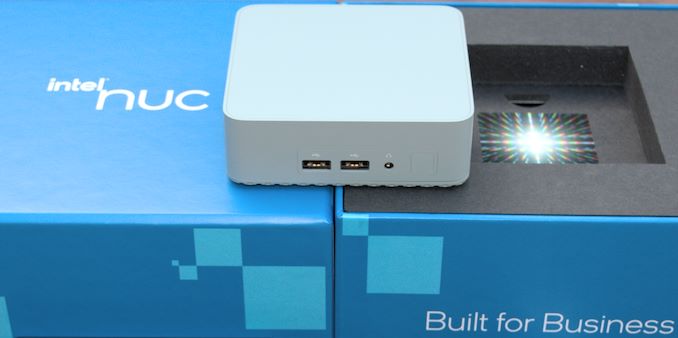
NUC12WSKv7 - An Updated Chassis Color Scheme
The new case design above is a preview of the plans for future 4x4 NUC models. The perforated case bottom can be removed without the aid of any tools to get access to the underside of the system (for the installation of the RAM and SSD).
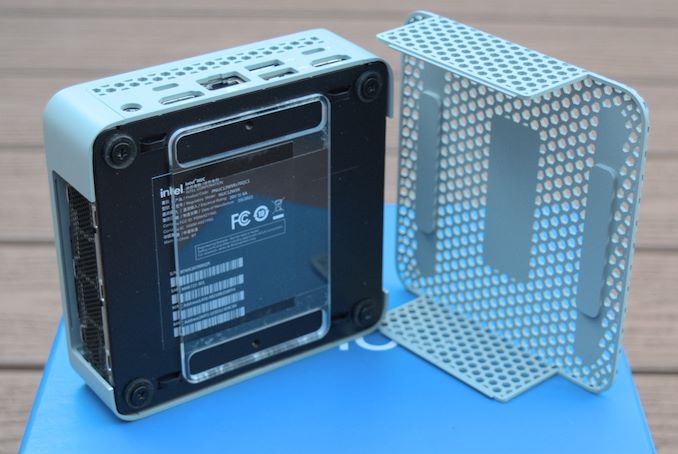
NUC12WSKv7 - 4x4 Designer Version Preview
The third NUC model is the Bleu Jour Meta 12. The Meta series of fanless systems from Bleu Jour is geared towards industrial applications. The Meta 12 uses the Lite board - the NUC12WSBi70Z - which does away with the Type-C ports. A key difference is the presence of a DC power input connector in addition to the regular power adapter connection.
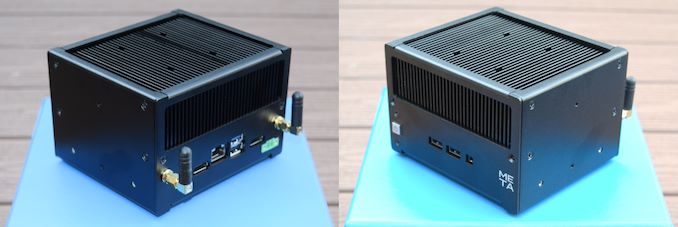
Bleu Jour Meta 12 (NUC12WSBi70Z) Fanless Rugged Industrial PC
The gallery below presents additional photographs of the internals of the above three systems.
The full specifications of the normal and vPro review samples are provided in the table below. The Bleu Jour Meta 12 is essentially the same as that of the NUC12WSKi7, except for the absence of the two Thunderbolt 4 Type-C ports.
| Systems Specifications (as tested) |
||
| Intel NUC12WSKi7 (Wall Street Canyon) | Intel NUC12WSKv7 (Wall Street Canyon vPro) | |
| Processor | Intel Core i7-1260P Alder Lake 4P + 8e / 16T, up to 4.7 GHz (P) / 3.4 GHz (e) Intel 7, 18MB L2, 28W (PL1 = 40W, PL2 = 64W) |
Intel Core i7-1270P Alder Lake 4P + 8e / 16T, up to 4.8 GHz (P) / 3.5 GHz (e) Intel 7, 18MB L2, 28W (PL1 = 40W, PL2 = 64W) |
| Memory | Crucial CT16G4SFRA32A.C16FR DDR4-3200 SODIMM 22-22-22-52 @ 3200 MHz 2x16 GB
|
Crucial CT16G4SFRA32A.C16FR DDR4-3200 SODIMM 22-22-22-52 @ 3200 MHz 2x16 GB
|
| Graphics | Intel Iris Xe Graphics (96EU @ 1.40 GHz) |
Intel Iris Xe Graphics (96EU @ 1.40 GHz) |
| Disk Drive(s) | Kingston KC2500 SKC2500M8500G (500 GB; M.2 2280 PCIe 3.0 x4 NVMe;) (Kioxia BiCS4 96L 3D TLC; Silicon Motion SMI 2262EN Controller) |
Kingston KC2500 SKC2500M8500G (500 GB; M.2 2280 PCIe 3.0 x4 NVMe;) (Kioxia BiCS4 96L 3D TLC; Silicon Motion SMI 2262EN Controller) |
| Networking | 1x 2.5 GbE RJ-45 (Intel I225-V) Intel Wi-Fi 6 AX211 (2x2 802.11ax - 2.4 Gbps) |
1x 2.5 GbE RJ-45 (Intel I225-LM) Intel Wi-Fi 6 AX211 (2x2 802.11ax - 2.4 Gbps) |
| Audio | Digital Audio with Bitstreaming Support over HDMI Ports 3.5mm stereo headset jack (Realtek audio codec) |
Digital Audio with Bitstreaming Support over HDMI Ports 3.5mm stereo headset jack (Realtek audio codec) |
| Video | 2x HDMI 2.0b 2x Display Port 1.4a with HBR3 over Thunderbolt 4 |
2x HDMI 2.0b 2x Display Port 1.4a with HBR3 over Thunderbolt 4 |
| Miscellaneous I/O Ports | 2x USB 3.2 Gen 2 Type-A (Front) 1x USB 3.2 Gen 2 Type-A (Rear) 1x USB 2.0 Type-A (Rear) 2x Thunderbolt 4 (Rear) (Type-C) |
2x USB 3.2 Gen 2 Type-A (Front) 1x USB 3.2 Gen 2 Type-A (Rear) 1x USB 2.0 Type-A (Rear) 2x Thunderbolt 4 (Rear) (Type-C) |
| Operating System | Windows 11 Enterprise (22000.1455) | Windows 11 Enterprise (22000.1516) |
| Pricing | (Street Pricing on January 25th, 2023) US $660 (barebones) $843 (as configured, no OS) |
(Street Pricing on January 25th, 2023) US $827 (barebones) $1010 (as configured, no OS) |
| Full Specifications | Intel NUC12WSKi7 Specifications | Intel NUC12WSKv7 Specifications |
In the next section, we take a look at the BIOS options along with an analysis of the motherboard platform. Following that, we have a number of sections focusing on various performance aspects before concluding with an analysis of the value proposition of the systems.


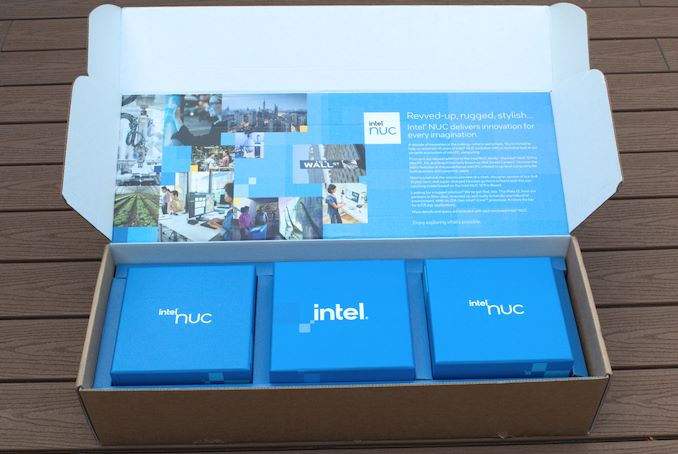
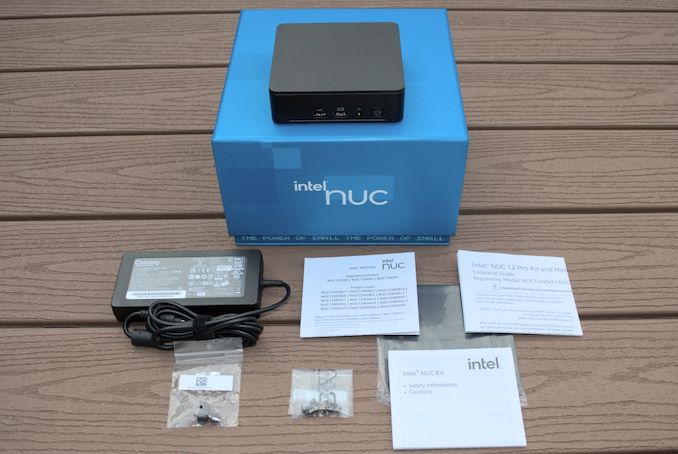














25 Comments
View All Comments
dontlistentome - Thursday, January 26, 2023 - link
There's quite a few discounts floating around for the 11th gen at the moment, so probably a better bet for many users.As ever Intel send the i7 - i've been looking at the i3-1220p version - effectively the i5-1235u - 2x P plus 8x E cores should be better thermals, still great peak performance and should live nicely in an Akasa Turing case fanless. Only frustration is there onlyseems to be about £40 between the i3 and i5.
I think if you're using these as a desktop the Dell/HP/Lenovo micro desktops are a better bet - bigger for better cooling so should be quieter.
1_rick - Thursday, January 26, 2023 - link
I've been using a Beelink SEI12 for a couple of weeks, the 1235U version, and it's pretty impressive, all things considered. I did notice that out of the box it will tend to be power limited to keep the fan noise reasonable: Prime95 settles in very quickly to a speed of around 2500MHz for the P cores and 100MHz slower for the E cores. But if you're doing anything that isn't that computationally intensive, it feels plenty snappy, especially compared to, say, a 5yo Dell Latitude (even when that was new). Surprisingly, it'll even play Minecraft (unmodded) pretty well.dontlistentome - Friday, January 27, 2023 - link
Nice. I've got an i7-1260p thinkpad from work and it's a furnace that thermally throttles constantly. I don't need 4 fat cores for a box that will be running pretty gentle server services (basic file-sharing, MySQL for Kodi, Roon, Home Assistant etc) two can handle the peaks with the E cores humming away in the background. I may just go for an 8 E core i3-300N box if they appear soon.nandnandnand - Friday, January 27, 2023 - link
It might be worth it to go to 1215U or 1235U instead depending on the use case. Alder Lake-N drops a memory channel, supports only 16 GB memory, and drops many of the PCIe lanes. If the specs on ARK are accurate. Even the weird Intel Processor U300 might be better.diamondsw - Thursday, January 26, 2023 - link
Given the recent introduction of the M2 Mac Mini, it would be very interesting to see how Intel's small form factor integrated system compares to Apple's. We haven't seen much head-to-head between Intel and Apple Silicon in a while, and a lot has changed (more for Intel than Apple). I imagine performance and power consumption would be closer these days.timecop1818 - Thursday, January 26, 2023 - link
What do you need to compare? The NUC runs a real OS and can actually be used for serious work, while the apple offering can only scroll Facebook and Instagram but at 120HzGrabo - Thursday, January 26, 2023 - link
While "a real OS" and "serious work" makes your comment harder to take seriously you have a point in that the Nuc can run any OS (except perhaps macOS) whereas the Macmini is closely associated with MacOS (I hope Asahi gets to where it wants to go and enables Linux on Apple's arm implementation). I have little doubt the Macmini is the more power efficient machine, especially the M2. (Am currently writing this on a NUC12WSHi5. It works pretty well but don't force it to do 120Hz and play youtube videos. I kind of wish more reviewers would mention the NUC fan. Even at "quiet" it behaves like the small fan that it is, sudden jumps to 100% fan noise as the CPU or GPU load suddenly increases)Kuhar - Friday, January 27, 2023 - link
I agree with you 100% - both on comment about Apple and NUC. The problem with those NUC fans is IMHO their coolers arent big enough (not enough mass - same problem with most laptops) so the fan starts every time even for relatively small temperature increase. And the fan curve isnt to my liking aswell - i would prefer if fan would spin constantly with lower RPMs than to start/stop all the time.max - Friday, February 3, 2023 - link
Because it'll be interesting. That's why. Mabye not for the wintel-fanboys like You, which need couple of years to grow up. MacOS i very powerful OS, and Apple hardware is the best in its class. I agree, maybye not for kids like you, so don't bother. Nobody cares what is your opinion.erotomania - Thursday, January 26, 2023 - link
Thanks Ganesh!$167 for a 100 MHz clock bump (1260P -> 1270P). Anything else included with that? I looked and could not find.